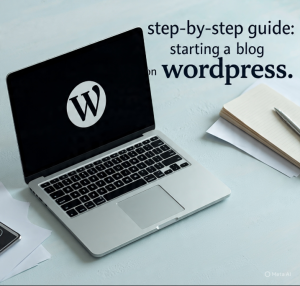Step-by-Step Guide: Starting a Blog on WordPress

Want a professional, high-converting blog that ranks, earns, and qualifies for Google AdSense? This guide walks you through every practical step — from picking a niche and buying a domain, to installing WordPress, optimizing for speed and search, and meeting AdSense requirements. Read it once, follow the checklists, and you’ll have a production-ready site you can monetize and scale.
Quick summary (key takeaways)
- Choose self-hosted WordPress (WordPress.org) for full control, advanced SEO, and AdSense monetization. WordPress needs a server with PHP, MySQL/MariaDB and HTTPS.
- Budget: domain $10–$20/yr; shared hosting $3–$15/mo; managed WordPress $20+/mo — pick based on skill and traffic goals.
- AdSense basics: you must own the site, be 18+, and meet Google’s content & policy standards; prepare trust pages and quality content before applying.
- Musts before launch: 15–30 high-quality posts, About/Contact/Privacy pages, fast mobile-friendly design, analytics + Search Console, clear navigation, cookie/consent management if you serve EU/UK.
Why WordPress (self-hosted) — the short case
Self-hosted WordPress (download from WordPress.org and install on your hosting) gives you full ownership of files, databases, plugins, and advertising code — which is essential if you want to run AdSense, advanced affiliate setups, or programmatic ads. Hosted alternatives make publishing easy but often limit monetization and advanced SEO. If you want a transferable asset that you can sell later, self-hosted WordPress is the industry standard.
Step 0 — Decide your blog’s purpose and niche (10–30 minutes)
Be specific. “Personal finance for Nigerian freelancers” outranks a generic “finance” blog in search and conversions. A clear niche guides content, keywords, and monetization (ads, affiliates, products).
Action steps:
- Write a 1-sentence mission statement.
- List 5 audience pain points.
- Pick 3 content pillars (e.g., How-to, Tools/Reviews, Case studies).
Step 1 — Choose and register a domain (30–60 minutes)
Best practice:
- Pick a short, memorable name (brandable, avoid hyphens).
- Prefer .com when possible; consider .ng or .com.ng for strongly local audiences.
- Buy privacy protection if you don’t want WHOIS details public.
Cost expectation: plan $10–$20 per year for a standard TLD; some TLDs cost more. Compare registrars for renewal fees.
Action steps:
- Brainstorm 5 names.
- Check availability with Namecheap / Google Domains.
- Buy the domain and enable WHOIS privacy (optional).
Step 2 — Pick a hosting plan (1–2 hours)
Hosting choices:
- Shared (cheap starter) — $3–$10/mo: good for small blogs.
- Managed WordPress — $20+/mo: automated backups, staging, security, faster support. Good for publishers who don’t want sysadmin chores.
- VPS / Cloud — $5–$80+/mo: scalable if you expect spikes or technical customization.
Pricing and feature ranges vary; check host’s resource limits, PHP versions, backups, and upgrade path.
Recommended quick picks:
- Budget: Hostinger, Bluehost (easy setup).
- Mid-range: SiteGround, Cloudways.
- Premium managed: Kinsta, WP Engine (best performance & support).
Action steps:
- Choose host based on budget & future traffic.
- Purchase hosting and link your domain (hosts usually provide DNS guidance).
Step 3 — Server requirements & preparation
WordPress core needs:
- PHP (recommended 7.4+; many hosts now recommend 8.0+).
- MySQL 5.7+ or MariaDB 10.3+.
- HTTPS support (let’s Encrypt free SSL available on most hosts).
Action steps:
- Confirm server meets WordPress requirements in the host dashboard.
- Enable HTTPS (install a free Let’s Encrypt certificate).
- Create a database if doing a manual install (most hosts provide one-click installers).
Step 4 — Install WordPress (15–30 minutes)
Two main ways:
- One-click install via your host’s control panel (cPanel/managed dashboard). Fastest.
- Manual install: download from WordPress.org, upload, create DB, run the web-based installer. Useful for custom setups.
Action steps (one-click):
- Log into hosting control panel → find “WordPress” or “Auto-installer.”
- Choose domain, admin username (not “admin”), strong password, site title.
- Run installer, then log into
yourdomain.com/wp-admin.
Action steps (manual):
- Download WordPress ZIP from WordPress.org.
- Upload files to
public_htmlvia FTP or file manager. - Create MySQL DB + user in cPanel.
- Edit
wp-config.phpwith DB details, visit site to finish installation.
Step 5 — Essential WordPress settings (30–60 minutes)

From the dashboard → Settings:
- Permalinks → choose “Post name” for SEO-friendly URLs.
- Reading → Set homepage (static page or latest posts).
- General → update site title/tagline, timezone, language.
- Discussion → control comments, moderation settings.
- Users → set Admin profile; create editor/contributor later.
Action steps:
- Install an SSL plugin if host doesn’t auto-handle SSL.
- Delete default “Hello World” post and sample page.
Step 6 — Pick a theme & basic design (1–3 hours)
Choose a responsive, lightweight theme. Avoid heavy multipurpose themes without testing performance.
Popular options:
- Lightweight: GeneratePress, Astra, Kadence.
- Page-builder friendly: Elementor (use carefully for speed).
Action steps:
- Install theme from Appearance → Themes.
- Configure header, footer, menus (Appearance → Menus).
- Make sure site looks good on mobile using Chrome DevTools.
Step 7 — Install must-have plugins (30–90 minutes)
Core plugin categories and examples (install only what you need):
- SEO: Rank Math or Yoast SEO — manage sitemaps, meta titles, schema.
- Caching / Speed: WP Rocket (paid) or LiteSpeed/W3 Total Cache. WP Rocket often delivers noticeable speed improvements.
- Security: Wordfence or Sucuri – firewall + malware scanning.
- Backups: UpdraftPlus (automated off-site backups).
- Forms: WPForms or Ninja Forms — contact & lead capture.
- Analytics/Google: Site Kit by Google integrates Search Console, Analytics, and AdSense.
- Image optimization: ShortPixel, Smush, or built-in host tools.
- Cookie/CMP (if you serve EU/UK): choose a Google-certified CMP if you plan to run personalized ads in EEA/UK. Google requires a certified CMP for personalized ads.
Action steps:
- Install plugins, then configure minimal settings (Don’t leave defaults that conflict with performance).
- Keep plugin count lean — each plugin adds overhead.
Step 8 — Create cornerstone pages & trust signals (2–4 hours)
Before you apply for AdSense or aggressively promote the site, build trust pages and core content.
Must-have pages:
- About — explain who you are and why readers should trust you.
- Contact — working contact form and email.
- Privacy Policy — explicit mention of cookies, third-party ad networks, analytics.
- Terms of Service — if you sell products or memberships.
- Cookie/Consent — required (or strongly recommended) if you serve EU/EEA/UK users and run ads.
Action steps:
- Use a privacy policy generator and adapt to list Google Ads/Analytics if used.
- Add a simple footer menu linking to trust pages.
Step 9 — Content strategy & publishing plan (weekly ongoing)
Google values helpful, original content. Aim for quality over volume. Before you proceed Read More About CHOOSING THE RIGHT NICHE FOR YOUR BLOG IN 2025, this article will explain all you needs to know before creating your wordpress blog. https://blogging.financialliteracy.com.ng/choosing-the-right-niche-for-your-blog-in-2025/
Recommended starter approach:
- Publish 15–30 cornerstone posts before heavy monetization — long-form, well-researched articles (1,000–2,500 words depending on topic).
- Create a content calendar: 2 pillar posts + 4 supporting posts per month.
- Use keyword research (Ahrefs/SEMrush/Google Keyword Planner) to find low-competition queries.
Action steps:
- Map 10 pillar topics, 30 supporting blog post ideas.
- Use internal linking — connect new posts to pillar pages.
- Optimize on-page SEO: Title tags, meta descriptions, H1, image alt text, structured headings.
Step 10 — Speed & performance tuning (1–3 hours)
Good speed improves UX and SEO.
Quick wins:
- Use a caching plugin or host’s built-in caching.
- Compress & lazy-load images.
- Use a CDN (Cloudflare has a good free tier).
- Minify CSS/JS carefully (plugins like WP Rocket help).
- Test with Google PageSpeed Insights and Lighthouse, then fix issues.
Action steps:
- Run PageSpeed Insights, note top issues, fix one by one (images, blocking scripts, caching).
Step 11 — Security & backups (30–60 minutes initial, ongoing)
Do these immediately:
- Install security plugin; enforce strong passwords & two-factor auth.
- Schedule daily or weekly backups to remote storage (Dropbox, Google Drive).
- Keep themes, plugins, and core WordPress updated.
Action steps:
- Configure Wordfence/Sucuri scans.
- Set UpdraftPlus backup schedule and confirm restore test.
Step 12 — Connect Analytics & Search Console (30–60 minutes)
Why: Search Console helps you understand indexing and keyword performance; Analytics tracks user behavior.
Action steps:
- Install Google Site Kit or manually add Google Analytics 4 (GA4).
- Verify site in Google Search Console, submit sitemap (usually at
yourdomain.com/sitemap_index.xmlfrom SEO plugin).
Step 13 — Prepare for Google AdSense (before applying)
Google requires you to own and control the site, be 18+, and follow content policies. AdSense checks for original content, navigation, and trust signals. There’s no public hard minimum traffic threshold — quality matters more.
AdSense checklist:
- Own the domain and admin access.
- Have 15–30 well-written posts (not copied or spun).
- About, Contact, Privacy Policy pages live.
- Site loads and works on mobile.
- No policy-violating content (copyright, adult, copyrighted downloads, hate content).
Special note (EU/UK): If you intend to serve personalized ads to users in EEA/UK/Switzerland, Google requires a Google-certified CMP that supports IAB TCF — implement it before serving personalized ads.
Action steps:
- Add privacy/cookie language mentioning AdSense.
- Use Site Kit to add AdSense code once approved or insert code via plugin/manual method. Hostinger and other hosts have guides for inserting AdSense into WordPress.
Step 14 — Launch checklist (the final sweep)
- [ ] Site accessible on
https://and mobile-friendly. - [ ] About, Contact, Privacy Policy, Terms pages present.
- [ ] 15–30 original posts published and internally linked.
- [ ] Analytics & Search Console connected.
- [ ] Speed optimizations done (caching, CDN).
- [ ] Backups scheduled and tested.
- [ ] Security plugin active and scanning.
- [ ] Cookie/CMP implemented if serving EEA/UK.
Practical timeline (realistic plan)
- Day 1: Niche, domain, host, install WordPress, basic settings.
- Days 2–7: Theme, essential plugins, trust pages, first 3 posts.
- Weeks 2–8: Publish 12–25 posts (content calendar), tune speed & SEO, set up analytics.
- Week 9+: Apply for AdSense and scale traffic via SEO and outreach.
Cost snapshot (starter — 2025 market ranges)
- Domain: $10–$20 / year.
- Hosting: Shared $3–$15 / month; managed WP $20–$60+ / month.
- Theme (optional premium): $50–$100 one-time.
- Essential premium plugins (optional): $50–$200/year.
- Small marketing budget (optional): $100–$500 for initial outreach/ads.
How to add AdSense to WordPress (summary)
- Sign up for AdSense (use your Google account). Provide site URL and phone number.
- Wait for initial review — Google verifies ownership and policies.
- Once approved, add AdSense code via Site Kit or an Ad insertion plugin or directly into theme header/footer. Host guides walk through this process.
Common pitfalls & how to avoid them
- Using too many plugins → slows site. Use only essential, tested plugins.
- Thin, duplicate content → hurts ranking and AdSense approval. Focus on helpful originals.
- Ignoring mobile users → most traffic is mobile; test layout and speed.
- Skipping backups & security → recoverability matters; hackers target weaker sites.
SEO & content tips that actually move the needle
- Use long-tail keywords for early wins. Aim for user intent: “how to start a blog in Nigeria 2025” vs. “start blog”.
- Write comprehensive pillar posts (2,000–3,500 words) that answer multiple user queries and link to supporting posts.
- Add schema where relevant (FAQ schema, article schema) to increase rich snippet chances. (Most SEO plugins support schema.)
- Build 5–10 high-quality backlinks through guest posts, resource pages, and partnerships — avoid spammy link schemes.
Maintenance routine (monthly & quarterly)
Monthly:
- Update WP core, themes, plugins.
- Check backups & test restores.
- Review Analytics for traffic & top pages.
Quarterly:
- Run performance audit (PageSpeed / Lighthouse).
- Re-optimize top pages for search intent and CTR.
- Refresh old content and fix broken links.
Quick plugin starter list (copy-paste)
- Rank Math or Yoast SEO — SEO & sitemaps.
- WP Rocket or W3 Total Cache — caching & speed.
- Wordfence or Sucuri — security.
- UpdraftPlus — backups.
- Site Kit (Google) — Analytics, Search Console, AdSense integration.
- Cookie/CMP plugin (CookieHub/Usercentrics/CookieScript) if you serve EU/UK users.
AdSense readiness checklist (copy-paste before you apply)
- [ ] You are 18+ and own the site.
- [ ] Domain is top-level (yourdomain.com).
- [ ] 15–30 original quality posts covering your niche.
- [ ] About / Contact / Privacy / Cookie pages live.
- [ ] Site passes mobile usability and loads reasonably fast.
- [ ] Cookie/CMP installed for EEA/UK if you plan personalized ads.
Frequently Asked Questions — quick answers for common concerns
Q: Can I start free on WordPress.com and move later?
A: Yes, migrations are possible, but starting self-hosted saves migration complexity and preserves early SEO. (Note: some WordPress.com plans restrict ad code and plugins.)
Q: How many posts before AdSense?
A: No fixed rule — quality matters more than count. Many publishers wait until they have 15–30 well-written posts.
Q: Do I need a paid theme or plugins to rank?
A: No — good free themes and plugins can perform well. Paid options often offer convenience, performance, and support.
Q: Will WordPress slow my site?
A: WordPress itself is efficient; poor themes or excess plugins cause slowdowns. Optimize images, use caching, and choose good hosting.
Resources & references (for deeper reading)
- WordPress.org — Before You Install & Install guide. https://developer.wordpress.org/advanced-administration/before-install/
- Google AdSense — Eligibility & program overview. https://support.google.com/adsense/answer/9724?hl=en
- Hosting & server recommendations (pricing and requirements).
- CMP / EU user consent rules for personalized ads. https://support.google.com/admanager/answer/7673898?hl=en
Final call to action
Ready to launch? I’ll build you a production-ready WordPress starter bundle that includes:
- Domain & host recommendation tailored to your budget,
- A pre-configured WordPress install (theme + essential plugins),
- 10 SEO-optimized post outlines tailored to your niche, and
- An AdSense readiness report with exact fixes.
Send “Start my bundle” to support@financialliteracy.com.ngwith your niche and budget (e.g., “personal finance, ₦10,000/month”), and I’ll create a step-by-step implementation plan you can follow tonight.
